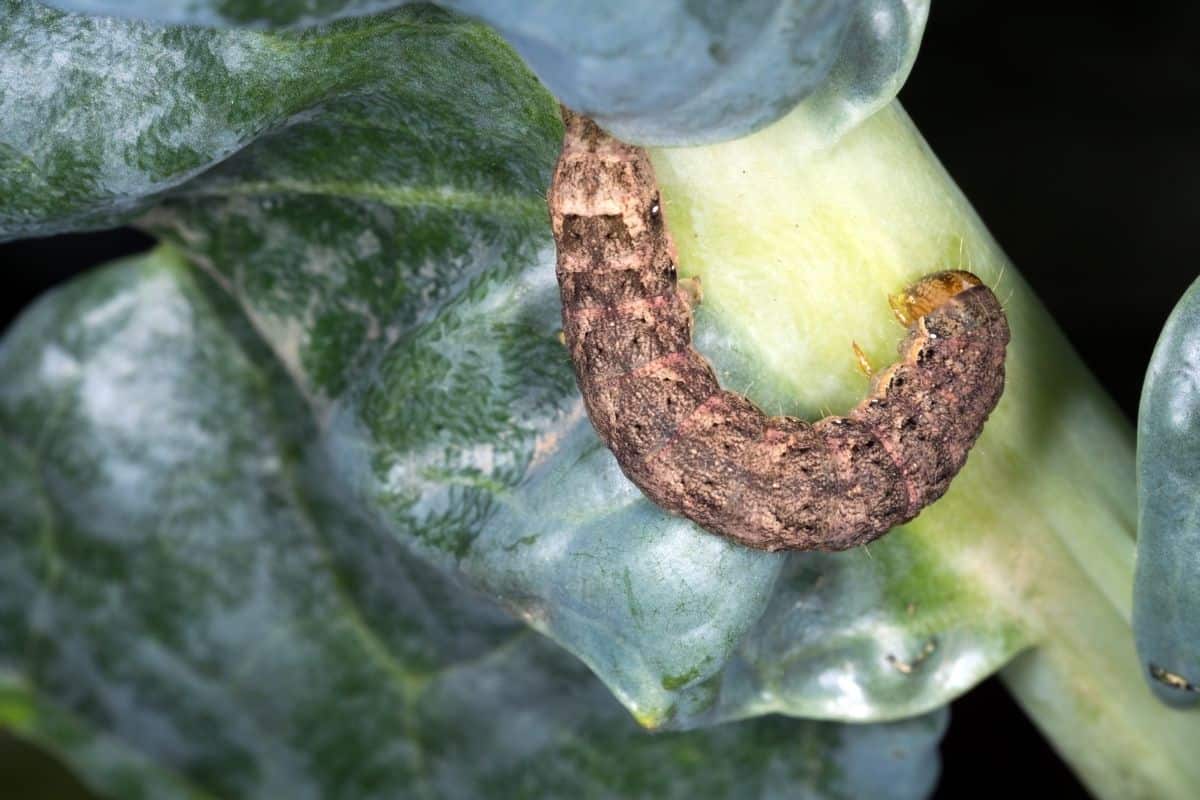I recently planted a bed of fall broccoli, collards, and kale, carefully covering the young transplants with row cover to keep out cabbage worms. But when I removed the cover to water the plants a day or two later, a few leaves and even an entire kale plant had been cut clean through the stems. Since the severed leaves remained wilting on the soil (rather than being consumed), I immediately thought, cutworms. After researching more about these nasty little pests, I’ve compiled some of my findings here about how to get rid of cutworms in the garden so you can save your fragile seedlings from damage too.

How to Get Rid of Cutworms in the Garden
Before we delve into methods for controlling cutworms, it’s important to properly identify cutworms and the damage they cause in the garden. Once you’ve confirmed the type of pest you’re dealing with, you can start implementing methods to get rid of cutworms. It often helps to try two or more options at once, and some of these will also help keep other pest populations in check.
How to identify cutworms

There are multiple species of cutworms, which vary in color, including shades of brown, gray, black, pink, and green. They might be uniformly colored or have stripes, spots, or a glossy appearance.
In general, though, these caterpillars reach up to two inches in length and have a smooth, nearly hairless body. When disturbed, a cutworm will curl up, forming a tight C shape. They may be difficult to spot, unfortunately, because they feed at night and hide in the soil during the day.
What cutworm damage looks like
Perhaps the best way to identify cutworms is by the damage they cause. Cutworms feed on a wide variety of vegetable plants, including:
- asparagus (learn how to grow asparagus)
- beans
- brassicas
- carrots (how to grow carrots)
- celery
- corn
- lettuce (how to grow lettuce)
- peas
- nightshades
New transplants are at the greatest risk of cutworm damage due to their tender stems. Although most damage occurs in the spring, it can continue through the summer.
Typically, a cutworm will curl around a stem to eat it, often cutting right through it. While damage usually appears just above the soil surface, some species feed on roots or will climb plants to eat leaves, buds, and fruit. Wilted plants cut off near the ground are a good indication of cutworms. To confirm their presence, run your hand over the soil within one foot of a damaged plant and look for the small caterpillars curled into a C.
How To Control Cutworms
1. Handpick early
The larger cutworms get, the more damage they do, so keep an eye out for these pests and take action as soon as you notice cutworm activity. Look for cutworms in the evening, when they are more active, and crush each one or drop them into a container of soapy water.
Remember to check the ground around each plant, rolling over clumps of soil and other potential hiding spots within a foot of the stem to look for the tightly curled caterpillars.
2. Clean up
Practice good garden hygiene! Adult cutworm moths typically lay their eggs in dead plant material and low-growing weeds, and weeds also serve as an alternate feeding site for cutworm larvae.
Knowing these facts, you’ll want to keep your garden tidy! Pull weeds regularly and make sure to remove all dead plant material promptly to make your garden less hospitable for cutworms as well as other insect pests.
3. Add a barrier
Barriers can be quite effective in controlling cutworms in smaller gardens. Since cutworms move from soil to stems to feed, a simple collar around each plant will keep them off of your crops.
Create a cylinder out of foil or use toilet paper or paper towel tubes. Cardboard tubes have the added bonus of being pre-formed – just cut them to length! – and biodegradable, so you don’t have to pick them up later. By the time the cardboard breaks down, the plant has grown too tough for cutworms to eat.
Make sure each collar is tall enough to bury one to two inches beneath the soil, to keep cutworms from tunneling under it, and stand two to four inches above the soil, to prevent them from climbing over.
4. Cultivate the soil
Because cutworms primarily live in the soil, cultivating is an effective way to expose and kill those already present. Till in the spring before planting to reduce populations of cutworms that overwintered, and till in the fall after cleaning up the garden to destroy eggs, larvae, and pupae poised to overwinter in your garden.
Although cover crops can provide ideal egg-laying sites, cutworm moths often finish laying their eggs by fall, meaning a late planting of a winter-hardy cover crop like winter rye in your freshly tilled garden might be okay.
Cutworms can be devastating to a freshly planted garden, but we have several effective options for getting rid of them. If you have cutworms in your garden, I hope these tips help you get growing again, so you can do more pottering and less worrying.
Want to learn more about how to keep pests away from your garden? You need this book: The Vegetable Garden Pest Handbook: Identify and Solve Common Pest Problems on Edible Plants – All Natural Solutions!



